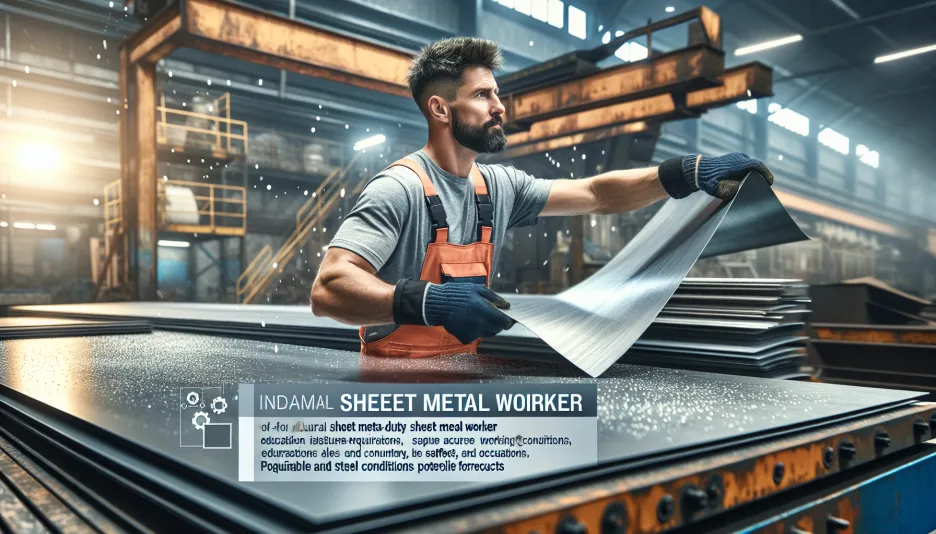- Salary statistics
- Industrial sheet metal workers, heavy sheet metal workers
Industrial sheet metal workers, heavy sheet metal workers salary
33 500 - 33 900 kr / month
Industriell tillverkning
Salary progression Industrial sheet metal workers, heavy sheet metal workers

Introduction to the professions of Industrial Sheet Metal Worker and Structural Steel Worker
Industrial sheet metal workers and structural steel workers are specialized professions within metalworking and construction. These professions require a combination of technical knowledge and practical skills to handle and shape large metal sheets used in various construction and manufacturing projects. The role often involves assembling and maintaining steel structures, requiring precision and a good understanding of drawings and technical specifications.
Salary for Industrial Sheet Metal Workers and Structural Steel Workers
The average salary for an industrial sheet metal worker and structural steel worker is 33 900 SEK per month. For men in the profession, the average salary is slightly higher, around 34 000 SEK, but specific salary data for women is not available. The profession also offers an hourly wage for those employed on an hourly basis, which is around 204 SEK based on a standard month with 166 working hours.
It is worth noting that the salary for industrial sheet metal workers and structural steel workers has increased from 32 800 SEK to 33 900 SEK since the last measurement, indicating a positive salary development within the profession.
Education and Qualifications
To become an industrial sheet metal worker or structural steel worker, a high school education in construction or an equivalent vocational training is usually required. Many employers also offer internal training and certifications to ensure that employees meet the specific requirements for their projects. Practical experience is a significant advantage, and apprenticeship programs can be an excellent entry path into the profession for beginners.
Working Conditions and Environment
The working environment for industrial sheet metal workers and structural steel workers can vary depending on the nature of the project. Many work indoors in factories or workshops, while others may work outdoors at construction sites. Safety is a high priority in this profession, and it is important to follow safety regulations carefully to avoid accidents. Protective equipment such as helmets, safety glasses, and gloves are often a necessary part of workwear.
Future Outlook for the Profession
According to the forecasts we have received from the Swedish Public Employment Service, it is difficult to make an exact assessment of the future outlook for industrial sheet metal workers and structural steel workers due to limited data. This means that while there is a need for these professions in industrial manufacturing, predicting the long-term demand is challenging.
Considerations Before Pursuing the Profession
If you are considering a career as an industrial sheet metal worker or structural steel worker, you should be aware of the physical demands of the job. You should be comfortable working with heavy materials and have good physical fitness. Additionally, having a basic technical understanding and an eye for detail is advantageous, as the work often requires precision and accuracy.
Benefits and Opportunities in the Profession
Benefits for industrial sheet metal workers and structural steel workers can vary depending on the employer. In some cases, there may be opportunities for paid training and certifications, which can help advance your career in the industry. While remote work is not a common benefit in this hands-on profession, flexible working hours may be offered depending on the project's needs.
Summary
Working as an industrial sheet metal worker or structural steel worker involves a practical and technical profession with diverse working conditions and opportunities for career development. With an average monthly salary of 33 900 SEK, there is a positive salary trend, and although the future outlook is difficult to assess accurately, it is a profession with a significant role in industrial manufacturing and construction. For those with a strong work ethic, an interest in technology, and a willingness to work physically, this can be a rewarding career path.
Salary distributed by age and sector
| Age | Base salary | Monthly salary | |
|---|---|---|---|
| Snitt | 33500 kr | 33900 kr |
| Age | Base salary | Monthly salary | |
|---|---|---|---|
| Snitt | 33500 kr | 33900 kr |
| Age | Base salary | Monthly salary | |
|---|---|---|---|
| Snitt | 33500 kr | 33900 kr |
| Age | Base salary | Monthly salary | |
|---|---|---|---|
| Snitt | 33600 kr | 34000 kr |
| Age | Base salary | Monthly salary | |
|---|---|---|---|
| Snitt | 33600 kr | 34000 kr |
| Age | Base salary | Monthly salary | |
|---|---|---|---|
| Snitt | 33600 kr | 34000 kr |
About the data
All information displayed on this page is based on data from the Swedish Central Bureau of Statistics (SCB), the Swedish Tax Agency and the Swedish employment agency. Learn more about our data and data sources here.
All figures are gross salaries, meaning salaries before tax. The average salary, or mean salary, is calculated by adding up the total salary for all individuals within the profession and dividing it by the number of individuals. For specific job categories, we have also considered various criteria such as experience and education.
Profession Industrial sheet metal workers, heavy sheet metal workers has the SSYK code 7215, which we use to match against the SCB database to obtain the latest salary statistics.
-

Process operators, stone crushing and ore processing
-

Machine operator, graphic industry, bookbinding
Bookbinders etc.
-
Other machine operators, textile, leather and leather industry
-

Other machine and process operators, steel and metal
-

Other process and machine operators
-

Process operators, paper
-
 Electricity prices
Electricity pricesElectricity Prices in Sweden: Free Electricity and Economic Tips
Sun, 24 Nov 2024 - 13:01 -
 Municipality
MunicipalityTax Pressure in Kiruna Municipality - An Overview of Tax Rates and Economic Challenges
Thu, 23 May 2024 - 22:26





